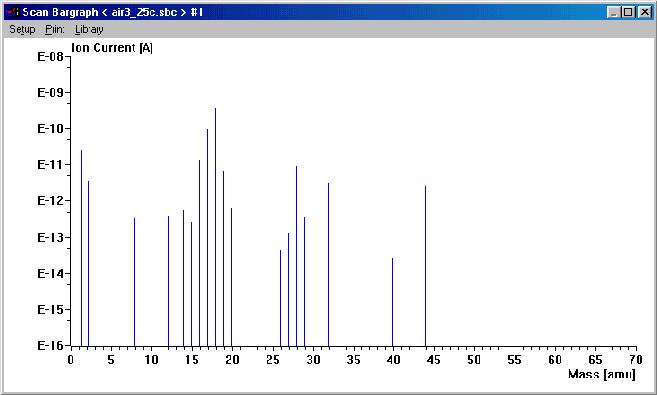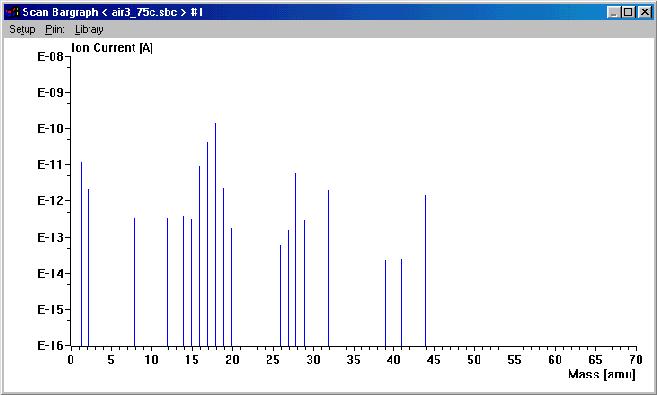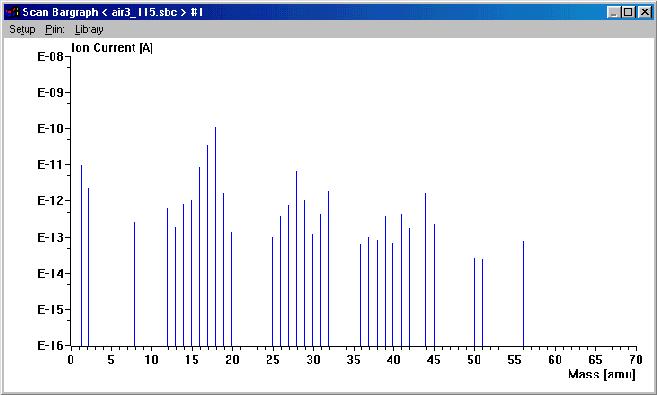Outgassing of CCD components in the Vacuum
Air Background Data
Before measuring the components, we made a scan of the empty vacuum chamber to obtain background data. The background comprises the air as well as outgassing from the electronical components of the probe holder's heating. Spectra of the probes were studied for qualitative and quantitative deviations from the background spectrum.
Within several weeks of running this experiment, the vacuum chamber became gradually cleaner because the vacuum pump was running continuously. The air background was therefore measured several times. Examples for the most recent background spectra are shown below. As the probes were scanned at varying temperatures, this was done for the background as well.
All following spectra are displayed in ion current units [A] in accordance with existing conventions. A scaling of the y-axis in pressure units was not possible with our software, and a manual conversion into partial pressures was not reasonable, as one gas component can cause different peaks. However, the conversion factor can be calculated from the sensor sensitivity, which is, for example, 6 x 10-4 A/mbar for argon and 8.1 x 10-4 A/mbar for krypton. The detection limit of the used residual gas analyzer is 2 x 10-12 mbar.
Lines in the spectra are labeled in atomic mass units [amu].
 Background at a temperature of 25° C on the probe holder. Three lines at 39 amu, 41 amu and 45 amu are semistable and did not appear at any time, as is the case here. "Semistable" means, the software truncates values below a certain level to zero instead of displaying them as noise. The intensity of these three lines fluctuated around the truncation level. |
For each displayed background spectrum we specify the individual lines. These may be evoked by various elements and a clear assignment is not always possible. At 25° C the background consists of:
| Line [amu] | Fragment ions |
| 1 | H+ |
| 2 | H2+ |
| 8 | O2+ |
| 12 | C+ |
| 14 | N+, CH2+, CO2+ |
| 15 | CH3+, NH+ |
| 16 | O+, CH4+, NH2+ |
| 17 | OH+, NH3+ |
| 18 | H2O+ |
| 19 | F+, Ar2+ |
| 20 | HF+ |
| 26 | C2H2+ |
| 27 | C2H3+ |
| 28 | N2+, C2H4+, CO+ |
| 29 | C2H5+ |
| 32 | O2+ |
| 39 | C3H3+, 39K+ |
| 40 | C3H4+ |
| 41 | C3H5+, 41K+ |
| 43 | C3H7+ (= alcohol fragment) |
| 44 | C3H8+, C2H4OH+ (= alcohol fragment), CO2+, N2O+ |
| 45 | C2H5O+(= alcohol fragment), 13CO2+ |
 Background spectrum at a temperature of 75° C on the probe holder. |
 Background spectrum at a temperature of 115° C on the probe holder. More lines appear here, caused by outgassing from heating components. |
At higher temperatures, outgassing from the probe holder's heating will merge with the background. At 75° C no new lines emerged, while at 115° C we found additionally the following lines:
| Line [amu] | Fragment ions |
| 13 | CH+ |
| 25 | C2H+ ? |
| 30 | C2H6+, NO+ |
| 31 | C2H2OH+, CF+ |
| 36 | H35Cl+, 36Ar+ |
| 37 | 37Cl+ |
| 38 | H37Cl+, C3H2+, 38Ar+ |
| 42 | C3H6+ |
| 50 | CF2+ |
| 51 | (unknown) |
| 55 | C4H7+ |
| 56 | C4H8+ ? |
